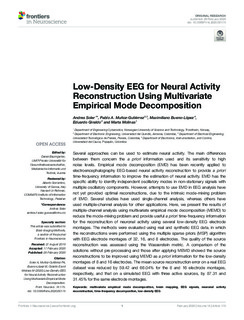| dc.contributor.author | Soler Guevara, Andres Felipe | |
| dc.contributor.author | Munoz, Pablo | |
| dc.contributor.author | Bueno-Lopez, Maximiliano | |
| dc.contributor.author | Giraldo, Eduardo | |
| dc.contributor.author | Molinas Cabrera, Maria Marta | |
| dc.date.accessioned | 2020-03-05T12:30:36Z | |
| dc.date.available | 2020-03-05T12:30:36Z | |
| dc.date.created | 2020-03-02T16:03:16Z | |
| dc.date.issued | 2020 | |
| dc.identifier.citation | Frontiers in Neuroscience. 2020, 14 . | nb_NO |
| dc.identifier.issn | 1662-4548 | |
| dc.identifier.uri | http://hdl.handle.net/11250/2645499 | |
| dc.description.abstract | Several approaches can be used to estimate neural activity. The main differences between them concern the a priori information used and its sensitivity to high noise levels. Empirical mode decomposition (EMD) has been recently applied to electroencephalography EEG-based neural activity reconstruction to provide a priori time-frequency information to improve the estimation of neural activity. EMD has the specific ability to identify independent oscillatory modes in non-stationary signals with multiple oscillatory components. However, attempts to use EMD in EEG analysis have not yet provided optimal reconstructions, due to the intrinsic mode-mixing problem of EMD. Several studies have used single-channel analysis, whereas others have used multiple-channel analysis for other applications. Here, we present the results of multiple-channel analysis using multivariate empirical mode decomposition (MEMD) to reduce the mode-mixing problem and provide useful a priori time-frequency information for the reconstruction of neuronal activity using several low-density EEG electrode montages. The methods were evaluated using real and synthetic EEG data, in which the reconstructions were performed using the multiple sparse priors (MSP) algorithm with EEG electrode montages of 32, 16, and 8 electrodes. The quality of the source reconstruction was assessed using the Wasserstein metric. A comparison of the solutions without pre-processing and those after applying MEMD showed the source reconstructions to be improved using MEMD as a priori information for the low-density montages of 8 and 16 electrodes. The mean source reconstruction error on a real EEG dataset was reduced by 59.42 and 66.04% for the 8 and 16 electrode montages, respectively, and that on a simulated EEG with three active sources, by 87.31 and 31.45% for the same electrode montages. | nb_NO |
| dc.language.iso | eng | nb_NO |
| dc.publisher | Frontiers Media | nb_NO |
| dc.rights | Navngivelse 4.0 Internasjonal | * |
| dc.rights.uri | http://creativecommons.org/licenses/by/4.0/deed.no | * |
| dc.title | Low-Density EEG for Neural Activity Reconstruction Using Multivariate Empirical Mode Decomposition | nb_NO |
| dc.type | Journal article | nb_NO |
| dc.type | Peer reviewed | nb_NO |
| dc.description.version | publishedVersion | nb_NO |
| dc.source.pagenumber | 17 | nb_NO |
| dc.source.volume | 14 | nb_NO |
| dc.source.journal | Frontiers in Neuroscience | nb_NO |
| dc.identifier.doi | 10.3389/fnins.2020.00175 | |
| dc.identifier.cristin | 1799041 | |
| dc.description.localcode | Copyright © 2020 Soler, Muñoz-Gutiérrez, Bueno-López, Giraldo and Molinas. This is an open-access article distributed under the terms of the Creative Commons Attribution License (CC BY). The use, distribution or reproduction in other forums is permitted, provided the original author(s) and the copyright owner(s) are credited and that the original publication in this journal is cited, in accordance with accepted academic practice. No use, distribution or reproduction is permitted which does not comply with these terms. | nb_NO |
| cristin.unitcode | 194,63,25,0 | |
| cristin.unitname | Institutt for teknisk kybernetikk | |
| cristin.ispublished | true | |
| cristin.fulltext | postprint | |
| cristin.qualitycode | 1 | |

